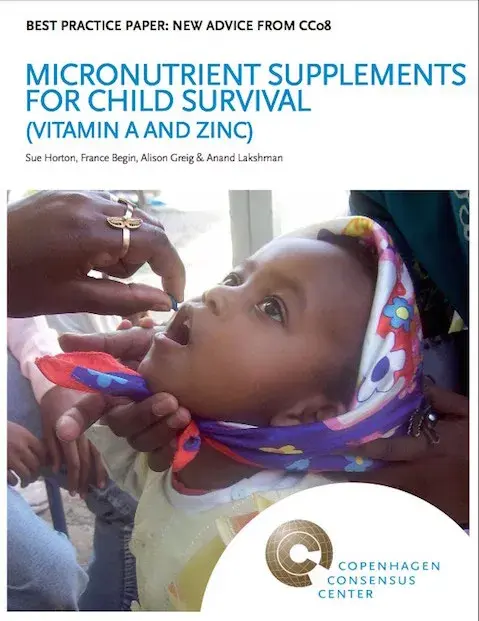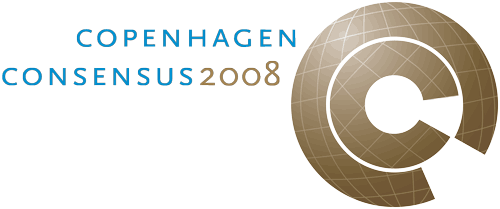Best Practice Papers
The ‘best practice papers’ build on the top solutions from the Expert Panel ranking of the Second Copenhagen Consensus conference. The intention is to provide decision-makers with more in-depth recommendations on a regional and project level. The ‘best practice papers’ add to the Copenhagen Consensus process with clear and focused empirical recommendations that can be taken to governments, international organizations, NGOs and philanthropists in both developed and developing countries. In this way, the aim is to provide an easily accessible list of suggestions regarding how to implement the top solutions from the second Copenhagen Consensus.
The ‘best practice papers’ also clearly document:
- to what extent the solutions are universal or specifically geographic, demographic, economic, or cultural, and whether they facilitate, or impede on the intervention and in this way modify the benefit-cost ratio.
- the variance across geographic, demographic, economic, and cultural differences in the benefit-cost ratio.
In order to ensure real hands-on experience, the lead author on each ‘best practice paper’ suggested at least one co-author to Copenhagen Consnesus. The most important qualification of the co-author(s) was practical experience, which could be obtained in various ways such as experience from national or international organizations.
The top-6 solutions (the Doha round is considered a special case, as Copenhagen Consensus considers this as being a question of getting it on top of the decision-makers agenda) are shown below. Click the links to read and download the Research Paper:
1. Micronutrient supplements for children (vitamin A and zinc)
The Second Copenhagen Consensus ranked micronutrient supplements as the top development priority out of more than 40 interventions considered. Specifically, vitamin A supplementation for children (every 4‐6 months, from age 6 months to 5 years) and therapeutic zinc supplementation for diarrhea (10‐14 days of supplementation, up to the age of 5) were considered. Vitamin A supplementation can reduce all‐cause mortality for children 6‐59 months by 23%, and several studies suggest that therapeutic zinc supplements for diarrhea can reduce diarrheal mortality below the age of five by 50%.
Lead Author: Susan Horton

2. Micronutrient fortification (iron and salt iodization)
The Second Copenhagen Consensus Expert Panel ranked fortification with micronutrients (i.e. vitamins and minerals), among the top three international development priorities. Specifically, fortification with iron and iodine, two minerals needed in small quantities in daily diets, was ranked as a top public health intervention priority for countries using benefit‐cost analysis. Undernutrition remains widespread around the world, despite significant reductions in income
poverty in recent years.
Lead Author: Susan Horton

3. Expanded immunization coverage for children
Childhood vaccination programs have had a dramatic impact on child morbidity and mortality worldwide. A universal effort to extend vaccination coverage to all children began in 1974, when the World Health Organization founded the Expanded Program on Immunization. This initiative helped countries establish the infrastructure needed to introduce and deliver a standard vaccine package, which in 1974 included the vaccine against diphtheria-tetanus-pertussis (DTP), measles-containing vaccine (MCV), polio vaccine (Pol), and Bacillus Calmette-Guérin (BCG) vaccine.
Lead Author: David Bloom

4. Biofortification
Biofortification was ranked fifth by the Second Copenhagen Consensus Expert Panel. A diverse diet rich in micronutrients is out of reach of many of the world’s poor. Because foods that are high in micronutrients such as vegetables, fruits, dairy, and meats are expensive, resource‐poor people rely primarily on a few starchy staples that are rich in energy, but not in micronutrients. By enhancing the micronutrient content of these energy‐rich staples, micronutrient intakes in general, and among the poor in particular, can be increased.
Lead Author: J.V. Meenakshi

5. Deworming and other nutrition programs at school
In 2008 the Copenhagen Consensus Expert panel ranked five nutritional interventions among the top ten of 30 proposals to answer the question, what would be the best ways of advancing global welfare? Deworming and other nutrition programmes in school were ranked as the sixth best intervention overall, considering their potential benefit:cost ratio, anticipated feasibility and the sustainability of the intervention.
Lead Author: Susan Horton

6. Lowering the price of schooling
In almost all countries of the world, schooling raises earnings. This is true in developing as well as developed countries. Similar returns to schooling are found for both urban and rural residents and for both women and men. The median increase in earnings varies from 8‐10% per added year of schooling. The returns are so commonly found and are sufficiently large to justify the Millennium Development Goal that every child should be given at least a primary education, the schooling level that nearly guarantees lifetime attainment of literacy in every country. This paper examine the benefits and costs of lowering parental schooling costs to improve educationl outcomes.
Lead Author: Peter Orazem


